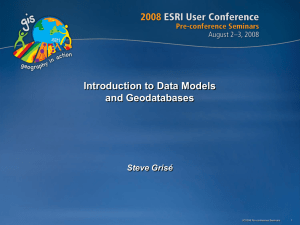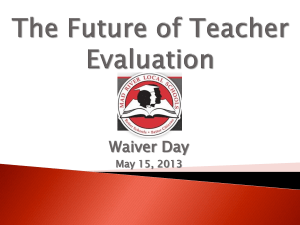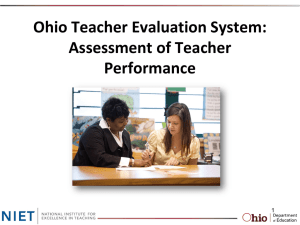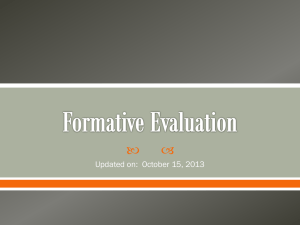Employer - Drinker Biddle & Reath LLP
advertisement
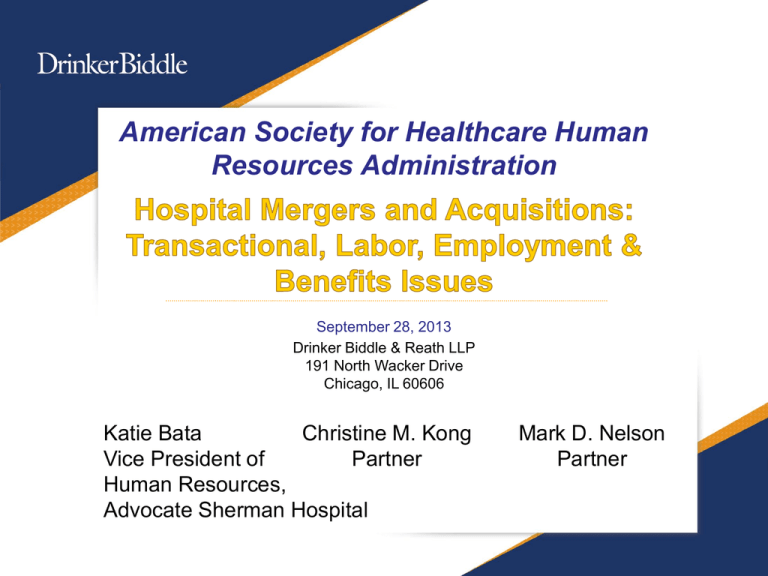
American Society for Healthcare Human Resources Administration September 28, 2013 Drinker Biddle & Reath LLP 191 North Wacker Drive Chicago, IL 60606 Katie Bata Christine M. Kong Vice President of Partner Human Resources, Advocate Sherman Hospital Mark D. Nelson Partner Overview > Reasons for increased hospital merger activity > Strategic transaction process > Strategies, objectives and principles > Board and management considerations > Stakeholders, regulators, interested parties > Strategic transaction structural options ASHHRA Pre-Conference Learning Session | September 28, 2013 2 Reasons for Increased Hospital Merger Activity > Access to capital and capital markets > Changes in care delivery > Changes in health care payment models > Health reform > IT infrastructure and EMR > Quality initiatives and accountable care > Revenue growth > Economies of scale and related efficiencies > Hospital/physician integration ASHHRA Pre-Conference Learning Session | September 28, 2013 3 Strategies, Objectives and Principles > Identify and develop key strategies, objectives, and principles – Different perspectives of parties and stakeholders – Prioritize Revisit, evaluate, and reaffirm/revise throughout the process > Strategies, objectives and principles must drive the transaction process > – Do not permit the process to eclipse the ultimate objectives – Avoid deal fatigue – Avoid organizational inertia > Strategies, objectives and principles provide basis for binding covenants/obligations and criteria for identifying and selecting a partner ASHHRA Pre-Conference Learning Session | September 28, 2013 4 Strategies, Objectives and Principles > Typical strategies and objectives – Improvement of strategic position in the market Managed care contracting leverage May be defensive transaction Enter new market Add facilities and equipment – Commitment of significant capital and improved access to capital markets – Long-term commitment to keep hospital as full service acute care facility Minimum commitment to maintain identified core services – Preserve local independence, governance and management – Protect employees and preserve work force in place Positions/titles, duties/responsibilities, salary/benefits, and severance ASHHRA Pre-Conference Learning Session | September 28, 2013 5 Strategies, Objectives and Principles > Typical strategies and objectives – cont’d – Protect the physicians on the Medical Staff – Recruitment of physicians to the community and medical staff – Employ physicians – Improve and expand quality initiatives – Commitment to IT and EMR – Commitment to the mission – charity care and community benefit – Receipt of fair market value – Reduce costs through economies of scale and efficiencies – Transaction completion certainty ASHHRA Pre-Conference Learning Session | September 28, 2013 6 Board and Management Considerations > The Board’s fiduciary duties – Duty of Loyalty Exercise authority in good faith and best interests of the organization and its charitable purposes Put non-profit interests ahead of proprietary ones Disclose/resolve all conflicts of interest Further the organization’s charitable purposes and mission Maintain confidentiality – Duty of Care Comply with all applicable laws. Protect and conserve assets Manage risk – professional/general liability Ultimately responsible for quality Avoid “over delegation” to clinicians/experts Be reasonably informed on all board matters Ask appropriately hard questions – reasonable inquiry Business judgment rule ASHHRA Pre-Conference Learning Session | September 28, 2013 7 Board and Management Considerations > Board and management considerations – Mission – Alternatives to transaction – Adequate and timely information to Board – Due diligence – Documentation – Participation of Board – Agreement regarding participation and roles of CEO and Board leadership Existing Board committee or special transaction committee? ASHHRA Pre-Conference Learning Session | September 28, 2013 8 Stakeholders, Regulators, Interested Parties > The community – patients > > > > > > > > and residents Parent corporation Employees Physicians Board Management Foundation and donors Bondholders and bond insurer/credit enhancers Other lenders and creditors ASHHRA Pre-Conference Learning Session | September 28, 2013 > Insurers and self-funded > > > > > > > employers Press Community organizations Attorney General Federal Trade Commission or U.S. Department of Justice DHSS and other State Agencies CMS/Medicare/Medicaid Joint Commission and other accreditation organizations 9 Strategic Transaction Structural Options > Asset purchase > Merger > Consolidation > Non-Profit change of control (e.g., member > > > > > substitution) Joint Venture Joint Operating Agreement Long-Term Lease Management Agreement Non-Profit Affiliation ASHHRA Pre-Conference Learning Session | September 28, 2013 10 Strategic Transaction Structural Options > Many factors drive the decision on transaction structure, including: – Debt structure and how best to handle liabilities – Availability of acquisition financing – Licensure, AG and other regulatory requirements – – – – – Enforceability of post-closing covenants Assignment and assumption of contracts (including leases) Joint ventures and assignment of interests Post-closing structural requirements of the acquiring party Financial reporting and tax issues and consequences – Employee benefit plan issues and transition considerations – Requirements of antitrust regulators ASHHRA Pre-Conference Learning Session | September 28, 2013 11 Simple Asset Purchase Asset Purchase Agreement Purchaser Seller Purchased Assets Purchase Price = $$$ + Any Assumed Debt and Liabilities ASHHRA Pre-Conference Learning Session | September 28, 2013 12 Typical For-Profit/Non-Profit Asset Purchase Acquiring System [For Profit] Asset Purchase Agreement Acquisition Subsidiary Net Proceeds Seller [501(c)(3)] [For Profit] $$$ Foundation [501(c)(3)] Purchased Assets Purchase Price = $$$ + Any Assumed Debt and Liabilities ASHHRA Pre-Conference Learning Session | September 28, 2013 13 Typical Non-Profit/Non-Profit Asset Purchase Acquiring System [501(c)(3)] Asset Purchase Agreement Acquisition Subsidiary Net Proceeds Seller [501(c)(3)] [501(c)(3)] $$$ Foundation [501(c)(3)] Purchased Assets Purchase Price = $$$ + Any Assumed Debt and Liabilities ASHHRA Pre-Conference Learning Session | September 28, 2013 14 Typical Simple Merger Before Closing After Closing Acquiring System Acquiring System Merger Agreement Acquisition Subsidiary Target [Survivor] Target [Survivor] Certificate and Plan of Merger ASHHRA Pre-Conference Learning Session | September 28, 2013 15 Typical Simple Consolidation Hospital A Corporation Hospital B Corporation Newco Hospital Corporation ASHHRA Pre-Conference Learning Session | September 28, 2013 16 Non-Profit Change of Control (or Substitution of Member) Before Closing Acquiring System After Closing Change of Control Agreement Change of Control Agreement Acquiring System System System Sole Controlling Member Sole Controlling Member Hospital Subsidiary Sole Controlling Member Target Hospital Hospital Subsidiary Target Hospital Amended and Restated Certificate of Incorporation and Bylaws ASHHRA Pre-Conference Learning Session | September 28, 2013 17 Joint Venture Example For Profit Hospital Company Management Services, LLC Non-Profit Health System Cash Contribution Cash or Asset Contribution $$ Subsidiary $$ 50 to 20% Ownership 50 to 80% Ownership JV, LLC Management Agreement 50/50 Board Hospital, LLC (operating company) ASHHRA Pre-Conference Learning Session | September 28, 2013 18 Joint Operating Agreement Non-Profit Health System Non-Profit Health System Joint Operating Agreement Contribution of Hospital $$ $$ Contribution of Hospital 50/50 Joint Operating Committee Hospital ASHHRA Pre-Conference Learning Session | September 28, 2013 Hospital 19 Labor, Employment and Benefits Issues ASHHRA Pre-Conference Learning Session | September 28, 2013 20 Obstacles to Successful Mergers > Cultures Too Different > Poor Integration > Operational Failings ASHHRA Pre-Conference Learning Session | September 28, 2013 21 Overview of Strategic Transaction Process Due diligence (legal, financial and operational) Identify concerns and objectives Decision to explore possible transaction Engage legal and financial advisors Objectives and criteria for partner Analysis of options Non-Disclosure Agreement(s) Identification of potential partners Negotiated deal or auction Select potential partner Definitive Agreement(s) Letter of Intent Closing Regulatory approvals Inform, educate, advise, and obtain input from key stakeholders (e.g., communication plan) ASHHRA Pre-Conference Learning Session | September 28, 2013 22 Avoid Due Diligence Snags > DD = 2-way street. Anticipate what the other party will want to know > Don’t wait for problems to be raised by other side > Pre-DD: Conduct internal evaluation of concerns, questionable practices, etc. – Will allow time to resolve or explain issue ASHHRA Pre-Conference Learning Session | September 28, 2013 23 Employment Issues ASHHRA Pre-Conference Learning Session | September 28, 2013 24 First Step: Understand Workforce 1. Union – – – 2. Single employer? Multi employers association? Acquisition Agreement MUST address CBA Non-Union – Generally more flexibility Retired 4. Inactive - LOA 3. ASHHRA Pre-Conference Learning Session | September 28, 2013 25 Collect Relevant Documents > Handbook > Employment > CBAs > Severance Policies > > Org Charts > Benefit SPDs and Plans > Job Descriptions > Offer Letters ASHHRA Pre-Conference Learning Session | September 28, 2013 > > > Agreements Restrictive Covenant Agreements Medical Staff ByLaws Hospital By-Laws Workforce Data 26 Understand Employee Compensation > Compensation Philosophy > Method of Performance Assessment > What Metrics Are Used > Job descriptions > Salary/Bonus structure > Pay practices & guidelines – Performance evaluation training? ASHHRA Pre-Conference Learning Session | September 28, 2013 27 Due Diligence: HR Practices > Employee Handbooks > Personnel Policies – LOA – Drug & Alcohol Testing – Anti-Discrimination – Elec. Communication – Record Retention – Discipline > Recruitment Process/Statistical Analysis of the Workforce > Employee Engagement/Satisfaction Surveys ASHHRA Pre-Conference Learning Session | September 28, 2013 28 Due Diligence: Compliance > Compliance Policies > Compliance Officer > Training & Education > Auditing & Monitoring Process > History of Compliance Complaints/Outcomes ASHHRA Pre-Conference Learning Session | September 28, 2013 29 Due Diligence: Insurance & Litigation > Threatened/Pending Lawsuits/Charges/ > > > > Claims/Arbitrations Litigation Outcomes/Settlements within 5 years EPLI/D&O Coverage Worker’s Compensation History Unemployment Compensation History ASHHRA Pre-Conference Learning Session | September 28, 2013 30 Union v. Non-Union Potentially Restricted by a Collective Bargaining Agreement (CBA) • Management Discretionary Action • Job Descriptions • Performance Management • Merit Pay • Incentives • Disciplinary Processes • Work Rules Outside Scope of CBAs • • • • Clear Goals Performance Tracking Training and Education Communication ASHHRA Pre-Conference Learning Session | September 28, 2013 • • • • Informal Rewards Staff Recognition Collaboration Shared Decision Making 31 Review the CBA > Calculate direct costs of CBA (i.e., wages, vacations, holidays) > Address important issues: – Are there any obligations for a subsequent employer – recognize the union(s) or adopt the CBA? – How broad is the union’s jurisdiction and does the bargaining unit exclude supervisors? – Is membership in the union a condition of continued employment? – How effectively does the CBA’s management rights clause reserve specific prerogatives to management? – Are there prohibitions on management’s right to subcontract, transfer or relocate bargaining unit work? – Does the CBA specify a guaranteed work week or minimum staffing in any manner? – How much notice is required prior to a reduction in force and how are RIF decisions made and when are they communicated to the union(s) and covered employees? – Limitations on employer’s right to assign/float staff? ASHHRA Pre-Conference Learning Session | September 28, 2013 32 Review the CBA > Are strikes and other work stoppages prohibited and are employees permitted to cross picket lines, or engage in sympathy strikes? > Is there a grievance/arbitration procedure and how are they defined? > How many grievances has union filed in past 3 years? What have been the outcomes? > Under what circumstances and in what amount is severance pay required? > What is the duration of the CBA and will it renew automatically? > Upon the sale or transfer of the business, is the seller required to obtain the purchaser’s agreement to be bound by the CBA? ASHHRA Pre-Conference Learning Session | September 28, 2013 33 Benefits Issues ASHHRA Pre-Conference Learning Session | September 28, 2013 34 Employee Benefits – Due Diligence > 401(k) Plans – tax-exempt or for-profit entities – Timely contribution of employee deferrals/employer contributions – Nondiscrimination testing (ADP/ACP testing) – Coverage testing – ERISA 404(c) status – Plan document current for legally required changes – Reporting and disclosure – Plan operation and administration ASHHRA Pre-Conference Learning Session | September 28, 2013 35 Employee Benefits – Due Diligence, con’t. > 403(b) Plans – tax-exempt entities only – Consistency of annuity providers/custodians practices with governing plan document – Timely contribution of employee deferrals/employer contributions – Nondiscrimination testing (match only) – ERISA 404(c) status – Plan document current for legally required changes – Reporting and disclosure - expanded Form 5500 disclosure requirements and plan audit – Plan operation and administration ASHHRA Pre-Conference Learning Session | September 28, 2013 36 Employee Benefits – Due Diligence, con’t. > Defined Benefit Pension Plans – tax-exempt or for-profit entities – Funding status/funding liability – Plan document current for legally required changes – Reportable events (PBGC) – Reporting and disclosure (PBGC and DOL reporting) – Plan operation and administration ASHHRA Pre-Conference Learning Session | September 28, 2013 37 Employee Benefits – Due Diligence, con’t. > Multi-employer pension plans – tax-exempt or for-profit entities – Withdrawal liability – Funded status – Plan document current for legally required changes – Reporting and disclosure/operation ASHHRA Pre-Conference Learning Session | September 28, 2013 38 Employee Benefits – Due Diligence, con’t. > Health, Welfare and Fringe Benefit Plans – Programs that are ERISA plans but have not been treated as such – COBRA compliance and potential liabilities – Funded status of health plans (insured or self-insured) – Plan or program documentation current for legally required changes – Compliance with the “cafeteria plan” rules and potential liabilities ASHHRA Pre-Conference Learning Session | September 28, 2013 39 Employee Benefits – Due Diligence, con’t. – Retiree medical or welfare arrangements – HIPAA compliance and potential liabilities – Accrued but unpaid vacation/sick pay and potential liabilities – Potentially affected employees currently on leaves of absence (type, duration) – MEWAs ASHHRA Pre-Conference Learning Session | September 28, 2013 40 Employee Benefits – Due Diligence, con’t. > Nonqualified Plans/Executive Compensation – tax-exempt or for-profit entities – Group arrangements (SERPs/top hat/excess benefit plans) – Individual arrangements – Assets to match liabilities (rabbi trusts) – Equity based arrangements (for-profit entities only) – Bonus arrangements – Plan documentation current for legally required changes – Compliance with Code Sections 409A, 457(b), 457(f), 451 ASHHRA Pre-Conference Learning Session | September 28, 2013 41 Employee Benefits – Due Diligence, con’t. > Employee/Severance/Change of Control Agreements – What promises have been made? – Are they consistent with or in conflict with terms of qualified, – – – – nonqualified and/or health/welfare plans and programs? Acceleration of vesting or right to exercise stock options upon change in control Acceleration of payment provisions upon change in control under employment agreements or severance arrangements Compliance with 409A and 457(f) (if tax-exempt) Documentation of severance obligations ASHHRA Pre-Conference Learning Session | September 28, 2013 42 Employee Benefits – Due Diligence, con’t. > Other issues – Documentation of major disputed claims under any plan, program or arrangement – Documentation of investigations or inquiries by any government agency regarding any plan, program or arrangement – Documentation of accelerated funding or vesting of benefits ASHHRA Pre-Conference Learning Session | September 28, 2013 43 Labor Issues ASHHRA Pre-Conference Learning Session | September 28, 2013 44 Overview > Rights and obligations regarding > > > > predecessor employer’s unions Successorship Doctrine Effect of the transaction structure Negotiating the CBA to facilitate the transition Post-transaction issues ASHHRA Pre-Conference Learning Session | September 28, 2013 45 Rights and Obligations of New Entity Vis-à-Vis Predecessor’s Unions > Set new terms and conditions of employment. Assume no obligations under the seller’s CBA, and avoid any obligation to recognize or bargain with the union. > Set new terms and conditions of employment. Recognize and bargain with the union, but do not assume the seller’s collective bargaining agreement (“CBA”). > Recognize the union, and assume seller’s CBA. ASHHRA Pre-Conference Learning Session | September 28, 2013 46 Understand the Rules Before Structuring the Transaction: SUCCESSORSHIP Subsequent Employer is free to set initial terms and conditions of employment without bargaining unless: It is a “Successor” ASHHRA Pre-Conference Learning Session | September 28, 2013 47 A Subsequent Employer is a “Successor” When There is: * Continuity of Operations; * Continuity of Workforce; * Ongoing Union Demand for Bargaining; and * Actions that make it “perfectly clear” the subsequent employer intends to hire the predecessor’s employees who comprise a majority of an appropriate bargaining unit with the subsequent employer. ASHHRA Pre-Conference Learning Session | September 28, 2013 48 Continuity of Operations > Business operations must remain relatively intact despite change in ownership > Relevant factors: – Length of time between cessation of former operations and start of new operations – Geographic proximity between old and new operations – Continuity in supervisory hierarchy – Similarity in services, customers or markets – Similarity in scope and methods of operations – Similarity in work performed and job classifications ASHHRA Pre-Conference Learning Session | September 28, 2013 49 Continuity of Workforce > Whether there is workforce continuity is determined when the subsequent employer employs a “substantial and representative complement” of employees, and a majority of the employees were employed by the predecessor and represented by a union in an appropriate bargaining unit. ASHHRA Pre-Conference Learning Session | September 28, 2013 50 Is There a “Substantial and Representative Complement?” * Has the subsequent employer substantially filled all job classifications in which union-represented employees worked under the prior employer? * Have normal or substantially normal operations begun? * How large was the workforce when normal operations began? * How much time will elapse before the workforce will expand significantly? * How likely is a projected workforce expansion? ASHHRA Pre-Conference Learning Session | September 28, 2013 51 Demand for Bargaining > Until the union makes a bargaining demand, the new employer has no duty to consult with the union over terms and conditions of employment. ASHHRA Pre-Conference Learning Session | September 28, 2013 52 What Are the Successor’s Obligations? > Recognize an incumbent union for a “reasonable period of bargaining” without challenging its majority status. > Abide by existing terms and conditions of employment. > Remedy its predecessor’s unfair labor practices of which it was aware at the time of the business transaction. ASHHRA Pre-Conference Learning Session | September 28, 2013 53 Steps Purchaser Can Take to Avoid Assuming or Adopting CBA > Before commencing operations, expressly disavow intention to be bound by the contract in writing to the union. > Clearly state that purchaser will not be applying, adopting or assuming seller’s CBA > Avoid consulting with the union regarding possible concessions by union before the transaction closes. > Ensure that transaction documents do not inadvertently assume or adopt CBA. - Merger agreement providing “successor shall be responsible and liable for all liabilities and obligations of predecessor” was viewed as an express assumption of the arbitration provisions of the CBA and successor was required to conduct arbitration pursuant to predecessor CBA. United Food & Commercial Workers Union v. Morgan’s Holiday Mkts., Inc., 202 F.3d 280 (9th Cir. 1999). ASHHRA Pre-Conference Learning Session | September 28, 2013 54 To Avoid Finding of “Perfectly Clear” Successorship > Purchaser should refrain from announcing that it intends to hire full complement of employees and should preface discussions with union with statement that no determination has been made whether and to what extent predecessor employees will be hired. > Clearly inform employees that specific changes in employment terms will be implemented and are a condition of initial employees. > This information must reach predecessor employees at or before time predecessor employees apply for employment. > Make clear that employment applications will be considered only if they understand and accept new terms and conditions. ASHHRA Pre-Conference Learning Session | September 28, 2013 55 Effect of the Transaction Structure on Purchaser’s Labor Obligations > Stock purchase – Insufficient to alter existing bargaining obligations because ongoing operations are usually uninterrupted – business as usual. – Purchaser of majority of stock is obligated to recognize the union and adopt the existing CBA. – To ensure continuation of CBA, purchaser should advise the union of its intent to adopt the CBA and obtain its written consent. – Purchaser is required to redress unremedied unfair labor practices committed by seller. ASHHRA Pre-Conference Learning Session | September 28, 2013 56 Effect of the Transaction Structure on Purchaser’s Labor Obligations > Assets Purchase – Purchaser is not obligated to adopt seller’s CBA. – Purchaser has the right to hire complete new workforce and to set new terms of employment… – So long as it is not discriminating against predecessor’s employees because of their union status or affiliation. – BUT…..BE CAREFUL! ASHHRA Pre-Conference Learning Session | September 28, 2013 57 Effect of the Transaction Structure on Purchaser’s Labor Obligations > If the sale of assets was merely a sham transaction, undertaken to avoid an obligation to adopt the CBA or bargain with the union, the purchaser will be deemed an “alter ego,” bound by the seller’s agreement. > Alter ego status is found where two enterprises have substantially identical management, business purpose, operation, equipment, customers and supervision. ASHHRA Pre-Conference Learning Session | September 28, 2013 58 Effect of the Transaction Structure on Purchaser’s Labor Obligations > Asset purchaser may be deemed a Successor which engenders a duty to recognize and bargain with the union representing seller’s employees if: – Purchaser acquires assets (not stock) or has otherwise taken over business of a predecessor; – Majority of successor’s workforce is made up of predecessor’s employees; – Successor’s business, as employees view it, is substantially the same; and – The employees’ terms and conditions of employment remain the same or substantially the same. ASHHRA Pre-Conference Learning Session | September 28, 2013 59 ASHHRA Pre-Conference Learning Session | September 28, 2013 60 Employee Benefits – Recent Deal Issues > Involve the benefits team sufficiently early in the process so the acquirer does not inadvertently assume sponsorship of plans when deal closes – In part a function of deal structure – In part a function of what the parties negotiate ASHHRA Pre-Conference Learning Session | September 28, 2013 61 Employee Benefits – Recent Deal Issues, con’t. > Treatment of the seller’s defined contribution plan (401(k), 403(b), profit sharing or money purchase) – Cannot merge 403(b) plans into 401(k) plans or vice versa – IRC rules may limit the buyer’s ability to terminate the seller’s 401(k) plan post-closing ASHHRA Pre-Conference Learning Session | September 28, 2013 62 Employee Benefits – Recent Deal Issues, con’t. > Treatment of outstanding loans under the seller’s defined contribution plan – Plans usually provide that employment termination accelerates outstanding loans – Negotiate for account balance, including loans, to be rolled over to the buyer’s plan – Bridge loans – If seller’s plan remains with seller or its controlled group, amend seller’s loan program to allow for repayment by former employees ASHHRA Pre-Conference Learning Session | September 28, 2013 63 Employee Benefits – Recent Deal Issues, con’t. > Correction of operational or reporting failures – Employee Plans Compliance Resolution System (IRS correction program) – Department of Labor Voluntary Fiduciary Correction Program (late transmission of employee contributions) – Department of Labor Delinquent Filer Voluntary Compliance Program (delinquent Form 5500s) ASHHRA Pre-Conference Learning Session | September 28, 2013 64 Employee Benefits – Recent Deal Issues, con’t. > Defined benefit pension plan issues – Underfunded defined benefit pension plans – Notice to the PBGC of the proposed transaction may be required due to change of plan sponsors controlled group – PBGC may require additional amounts be contributed to the plan ASHHRA Pre-Conference Learning Session | September 28, 2013 65 Employee Benefits – Recent Deal Issues, con’t. > Purchase agreement indemnification provisions – Consider specific indemnification provision depending on problems and exposure – Quantify the extent of the exposure and develop post-closing corrections methodology before closing – Dollar limit and notice requirements of indemnification provisions ASHHRA Pre-Conference Learning Session | September 28, 2013 66 Employee Benefits – Recent Deal Issues, con’t. > Examples of special challenges – Relative costs of retirement benefits – DB versus DC retirement programs – Provision of service credit for welfare and/or retirement – – – – – – benefits Governance of plans (i.e., delegations of authority) Premature promises Understanding the form of the transaction Affirmative and negative covenants Closing deliverables Escrow of part of the purchase price to pay certain claims ASHHRA Pre-Conference Learning Session | September 28, 2013 67 Lessons Learned: The Employment Perspective ASHHRA Pre-Conference Learning Session | September 28, 2013 68 In the Heat of the Deal, DON’T: > Forget to Involve Employment/HR > Forget to Address Employment Aspects of Hospital and Medical Staff By-Laws > Forget to Have a Coordinated Plan for PostTransaction Integration > Forget to Identify/Develop the Culture and Values of the New Entity and Compare them to the Cultures and Values of the Involved Entities ASHHRA Pre-Conference Learning Session | September 28, 2013 69 Address Integration Before Closing > Will purchaser employ all employees? > If not, who will decide which employees will not be hired and what process will be used? > Do you want personnel files? > Who has RIFs/WARN responsibility? > What is the plan for transitioning all involved entities to the new cultures/values, and who is responsible for this initiatives? ASHHRA Pre-Conference Learning Session | September 28, 2013 70 Manage the Message Percentage of Employees Strongly Agreeing with the Statement: “I Am Kept Informed of the Organization’s Future Plans and Direction.” 44% 20% Managers Frontline Staff Source: Advisory Board Survey Solutions Data Cohort, 2012; HR Investment Center interviews and analysis ASHHRA Pre-Conference Learning Session | September 28, 2013 71 Lessons Learned: > Implement well-planned integration quickly > Align organizational roles/responsibilities > Communicate new expectations > Clear, honest and frequent communication > Plan for resistance/reluctance/uncertainty ASHHRA Pre-Conference Learning Session | September 28, 2013 72 Managing Resistance > Be transparent > Identify “cheerleaders” > Maximize opportunities to maintain “status quo” > Minimize “surprises” about change > Emphasize benefits to all parties in transaction > Communicate “non-negotiables” > Humanize new leadership ASHHRA Pre-Conference Learning Session | September 28, 2013 73 Engage Key Stakeholders > Medical Staff Leaders > Managers > Union Leaders > Employees (dissenters, supporters and non-engaged) ASHHRA Pre-Conference Learning Session | September 28, 2013 74 Use “Town Halls” > Explain industry trends driving change > Prepare them for change > Ask for their help > Don’t over-promise or mislead > Don’t go off-script! > Anticipate negative Union reaction > “Listen” to the reaction ASHHRA Pre-Conference Learning Session | September 28, 2013 75 Lessons Learned: The Labor Perspective ASHHRA Pre-Conference Learning Session | September 28, 2013 76 Negotiating the CBA to Facilitate the Transaction > Successorship provisions in unexpired CBA (The Deal Killer) – May purport to bind successor to terms and conditions of parties’ – – – – existing CBA May “require” employer/seller to provide Union with notice prior to transaction and to condition terms of transaction on purchaser’s adoption of terms of CBA Not enforceable as against assets purchaser (under current NLRB law) May provide Union with avenue to seek an injunction if seller fails to ensure that purchaser adopts CBA - - threatens the transaction closing Sale may be stayed until after Union and seller have arbitrated the issue ASHHRA Pre-Conference Learning Session | September 28, 2013 77 Effects Bargaining > Seller is not required to bargain over core management decisions …an employer has the absolute right to terminate his entire business for any reason it pleases. > Seller is required to bargain over the effects of the sale or merger upon demand before completing the transaction. > Seller must provide: – Meaningful notice to the union of the transaction; and – Engage in good-faith bargaining over mitigating measures concerning “effects” issues (severance, outplacement, job counseling, transfer rights, payment for accrued PTO, seniority and pension rights). ASHHRA Pre-Conference Learning Session | September 28, 2013 78 Post-Transaction Issues > Workforce changes and bargaining units: – When employees hired by the successor previously belong to different bargaining units, the NLRB evaluates each unit separately to determine majority status. – If the purchaser’s bargaining unit has been so effectively merged into the seller’s bargaining unit or is so functionally integrated that it has lost its separate identity, the NLRB may consider it “accreted” or added to an existing unit without an NLRB election. – When purchaser takes over only a small part of the seller’s business or operations, the NLRB orders bargaining only if the unit within that part remains intact and appropriate which is more likely since Board’s “micro” bargaining unit decision in Specialty Healthcare, 357 NLRB No. 83 (2011). ASHHRA Pre-Conference Learning Session | September 28, 2013 79 Post-Transaction Issues > Merger or sale of business can trigger “withdrawal liability” for the employer’s share of the unfunded liability of the Multi-employer Pension Plan. > Asset purchases generally leave withdrawal liability with the seller, affecting sale proceeds. > Stock sales generally send it to the buyer generating a large liability after closing which could encumber future operations. ASHHRA Pre-Conference Learning Session | September 28, 2013 80 NLRB Pro-Union/Pro-Employee Stance Presents Legal Challenges to Employers > NLRB restores the “Successor Bar Doctrine” requiring employers to recognize incumbent unions for a reasonable period after a business transition without challenging the majority status of the employee representatives – no less than 6 months after the parties’ first bargaining session and no more than one year after the start of bargaining.” UGL-UNICCO Serv. Co. 357 N.L.R.B. No. 76 (8/26/11). > NLRB reaffirms potential successor liability for a predecessor’s unremedied unfair labor practices. Big Sky Hospitalities, LLC, 358 N.L.R.B. No. 83 (July 16, 2012). ASHHRA Pre-Conference Learning Session | September 28, 2013 81

